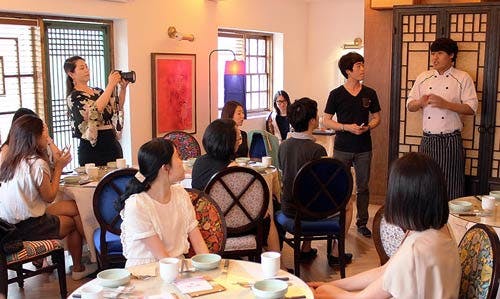U.S. Beef and Pork Featured at Social Dining Events in Korea

Diners are welcomed to Kyungsung Steak House in Seoul for a USMEF-sponsored social dining event
As a part of its effort to grow demand for U.S. beef and pork among a younger demographic, USMEF recently held a series of popular “social dining” events in Seoul, South Korea. Funding for the events was provided by the Beef Checkoff Program, the Pork Checkoff and the USDA Market Access Program (MAP).
Social dining is a popular new dining trend in which people meet at a restaurant or at home to connect over a meal. It is especially popular among young, single Koreans and is contributing to a significant change in Korea’s restaurant landscape.
The first social dining event brought together a group of young people at Kyungsung Steak House, one of Seoul’s most popular fusion restaurants. Invitations to the event were distributed through the popular social dining website, Zipbob, where it quickly became one of the most popular events in the site’s history.
“Once the event was posted on Zipbob, it sold out in three hours,” said Min Park, senior manager of public relations for USMEF. “It’s exciting to introduce high-quality, great tasting U.S. beef and pork to the next generation of Koreans, and this type of event demonstrates how U.S. meat can be part of a great dining experience.”

Participants in a home cooking demonstration enjoy entrées featuring U.S. beef and pork
Prepared by Kyungsung Steak House chef and owner Jinwoo Jang, diners were served a salad featuring U.S. pork jowl meat and a Prime U.S. strip steak. The dishes were part of a traditional Korean meal that typically consists of a bowl of rice, soup, bean paste, hot pot and seven side dishes. Chef Jang and the staff preparing the meal noted how impressed they were with the quality and versatility of U.S. pork and beef products.
The second event was a home cooking demonstration by well-known Korean cooking instructor Mikyung Jung. USMEF invited 20 single men and women who were paired prior to the class. Chef Jung prepared U.S. beef and pork entrées with traditional Korean accompaniments of rice, pork soup and several side dishes. Following the meal, couples participated in a quiz about the information they had learned that evening.
“In addition to the connections we made with young consumers, events like this also have the benefit of demonstrating to Korean chefs and restaurateurs that U.S. beef and pork work well in their venues and appeal to their customers,” explained Jihae Yang, USMEF Korea director.
Diners at both events remarked that they enjoyed both the trendy settings and the unique opportunity to learn more about U.S. beef and pork. Many noted that these events changed their prior perceptions of U.S. meat and that they now have a better understanding of its quality, flavor and safety. Attendees also commented that they look forward to trying U.S. beef and pork again in the future. To help USMEF connect with potential future participants, an influential food blogger was invited to each event to publicize the activities and discuss them online.
U.S. beef and pork exports to Korea have rebounded in 2014, posting impressive year-over-year gains. Through August, beef/beef variety exports totaled 76,144 metric tons (mt) – up 14 percent from a year ago – while value increased 44 percent to $522.1 million. Pork/pork variety meat exports increased 31 percent in volume to 89,334 mt, and were up 49 percent in value to $278.3 million.
